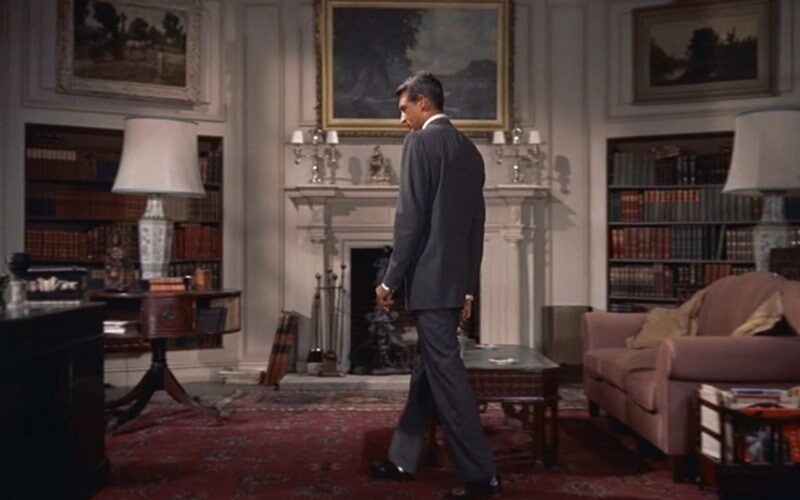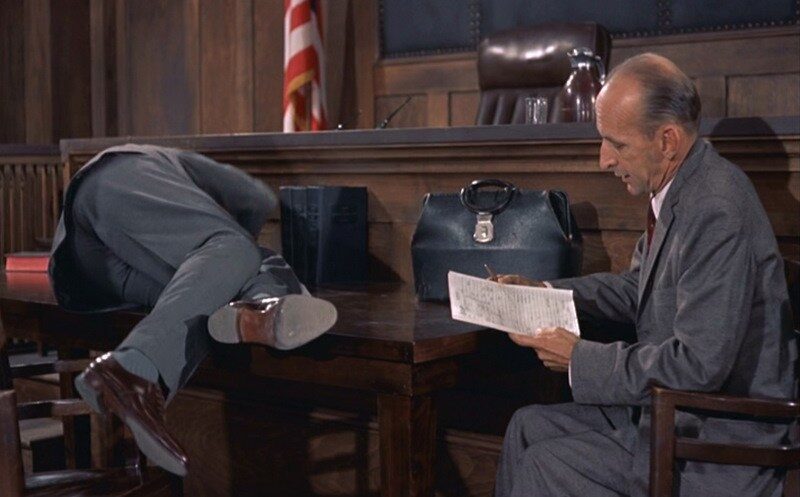North by Northwest: Cary Grant's Kilgour Suit | Clothes on Film – Part 843

Savile Row tailors Kilgour provided much of Cary Grant’s wardrobe for North by Northwest (1959). In all probability director Alfred Hitchcock left Grant to his own devices in selecting ensembles, just as he’d done on To Catch a Thief four years earlier.
If this was in fact the case, Hitchcock was not so trusting with Eva Marie Saint’s wardrobe. Disliking initial design sketches for her look, he escorted Marie Saint to New York’s swanky Bergdorf Goodman department store, personally choosing her outfits right off the racks. She later jokingly referred to Hitch as her “one and only sugar daddy”.
As for Cary Grant, by this stage in his career it was written into his contract that he could keep all the suits made for his movies. He was a stylish guy, but also frugal, apparently even charging autograph hunters fifteen cents for his signature.

Contrary to popular opinion, Grant had a tough initiation into stardom, first as an acrobatic performer in the UK and then on the unforgiving Vaudeville circuit in the U.S., before finally striking it big as a Hollywood actor in the early 1930s. Hardly surprising then that he liked to keep onto those suits so expertly tailored for him throughout his career.
This stylish, medium grey Glen check suit from North by Northwest, as worn by Grant’s protagonist Roger Thornhill/George Kaplan, is probably considered one of his best – certainly his most well known:

Lightweight wool single breasted suit, ventless, with three button fastening and notched lapels. Trousers with forward pleats. ‘Oxblood’ leather derby shoes worn with grey thin ribbed socks. White medium spread collar shirt with double cuff; light blue initialed cufflinks, grey silk tie.
The suit is apparently made by Kilgour French and Stanbury, specifically tailored by Arthur Lyons (who also made suits for Edward, Duke of Windsor). Yet this issue remains constantly in debate. At one point in the film a Quintino label can be glimpsed. Some say sixteen suits were created and used, which would seem par for the course when considering how much physical action Grant’s character undertakes and the different shot angles required. It seems probable then that several suits were made by different tailors from the same or similar pattern. The trousers on all suits are cut high for Grant’s typical waistband, fitting loose through the seat and thigh.
During the 1950s, Grant began following the Duke of Windsor’s example – having his suit jackets tailored at Savile Row and slimmer cut trousers made in New York. Either he was dressing for the scorching hot weather in North by Northwest, or else he just fancied a change. The full trousers do drape impeccably with the jacket though. And with those long legs, Grant could easily pull off a wider leg.

Ventless is unusual for an expensive single breasted jacket these days, yet have been familiar on double breasted suits since the ‘column’ look of the thirties. Grant apparently preferred double vents as he liked to put his hands in his pockets whilst acting. Without vents the jacket is forced up onto the hips causing it to crumple in an unsightly manner.
In North by Northwest, Grant stands in the desert with his hands in his pockets and looks as cool as a cucumber. The jacket is cut high alongside his trouser pockets so – especially with the bottom button undone – any crumpling is brief and minimal. All in all, six suits were used during filming.
Grant’s attention to detail with accessories is typically faultless. Always a keen interest of his, the selecting of that perfect neckerchief or pocket square; here he expertly offsets the ever-so-slightly boxy finish of his jacket with rounded silver cufflinks.

Likewise his particularly rich oxblood shoes cleverly contrast with the combined colour palette the suit (blue on charcoal grey). Those matching socks finish off the ensemble nicely. Not a glint of hairy leg either, not even when he’s clambering over a courthouse desk as drunk as a lord.
For the movie’s final act, Grant gets a controversial costume change. He dons what some view as an all-too-baggy white shirt (during close ups on Mount Rushmore you could be forgiven for thinking Grant was captaining a pirate galleon). The shirt was off the peg and made by Brooks Brothers, featuring their patented button-down collar, with single button cuffs.

Grant actually wore an off the peg Brooks Brothers blazer in real life; he was not always tailored to the eyeballs. Here too, within the context of the film, this shirt performs a function above that of helping Cary Grant look good. The change of clothes is given to him by The Professor (Leo G. Carroll) don’t forget, not selected from Thornhill’s own closet. Plus if you buy an off the peg shirt for a man with a 17.5″ neck then it is going to be baggy.
For a star that many consider to be one of the most stylish who ever lived, North by Northwest’s grey suit is his epitome. It’s clean, uncluttered and just a little bit controversial. In regards to what it means within the context of the film, this writer believes very little. Featuring a protagonist who is as much Cary Grant as Roger Thornhill, this is whom the costume represents. The man, the role; they are one and the same.
For more information on Cary Grant’s unmatched elegance try Richard Torregrossa’s excellent book Cary Grant: A Celebration of Style.
© 2009 – 2014, Lord Christopher Laverty.